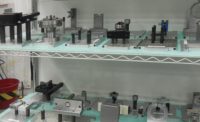Measurement plays a key role in the smart factory. If a manufactured part or building can be measured correctly, rapidly, and efficiently, productivity will soar. Industry 4.0, the new face of manufacturing, encompasses more consistent repeatability and higher flexibility. In essence, a smart factory utilizes scanning tools that measure components in new, faster ways.
Experts agree that, among other tools, digital twins are emerging as stars of smart factories. These are 3D duplicates of parts, products, and buildings. Engineers use these virtual duplicates to investigate a part’s features and flaws — characteristics that might not be evident in an original part.
Digital twin technology helps organizations to use real-time data, mockups, algorithms, and AI to create a virtual depiction of a physical object, process, or service. Such replicas are typically more affordable than physical prototypes, enabling organizations to create and test limitless versions.
The right visualization equipment, such as cameras, lasers, and sensors, gathers data to help engineers create and sustain such a model.
Across industries, experts are seeing more use of digital twins. That’s because this visualization technology complements the use of sensors that manufacturers already use to collect important production data. Now, they can use that data to create visual, interactive models. Ultimately, these models, or twins, help manufacturers to test and innovate.
They do this by using twins to improve system designs. They use digital twins to strategize and experiment with production lines, testing out possible glitches before creating a physical line. They can test new products in a less risky way, and they can also manage and maintain their lines in a virtual environment. Lastly, they can use twins to address asset lifecycle management. By using digital twin technology, technicians can view (typically with virtual reality glasses) the most up-to-date models of a machine and updated specs.






